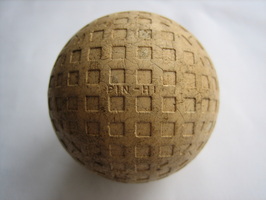Lake Balls - how good are they?

Pond balls (or lake balls) have come a long way in recent years. The introduction of the 2 piece and the 3 piece golf ball, that have superseded the wound and balata balls, has made the option to play with a pond ball so much easier, as they still have the playing characteristics of a new ball. The old balls were susceptible to water ingress that greatly effected their playing characteristics. Today, the new ball construction makes them immune to this problem and now one of the only side effects to spending some of its life under water is may be a slight change in the brightness of the outer cover. This will drop them out of the top A+ and A grades, but with no decline in performance. However, there are many ways that balls find their way back into the basket in the Pro-Shop.
Refinishing: This requires the outer layer of paint, lacquer and markings to be etched away by chemical means and then new paint, markings and lacquer applied. This is a process we DO NOT do. The finished product is always inferior in its wear characteristics, and thus when purchasing the ball gives a false impression of its durability. These balls will quickly find their way into your practice bag. Each ball 'should' have a small "Refinished by..." label imprinted on it.
Refurbishing: Once cleaned, the ball is given a fresh coat of lacquer. This smartens the appearance, but does little else. Our cleaning and polishing service restores the balls to their true playing characteristics yet, honestly gives an indication as to the history of each ball. Every golfer has an acceptance of what they consider to be a 'good ball' to play with, and knowing as much as possible about its past has to be useful information.
Our policy is to try and honestly describe each and every ball, so that each grade and make of ball can be relied upon.
Grading Criteria: For specified makes of ball, usually sold in multiples of a dozen. In each case see photographs within the site to illustrate the comments below.
Refinishing: This requires the outer layer of paint, lacquer and markings to be etched away by chemical means and then new paint, markings and lacquer applied. This is a process we DO NOT do. The finished product is always inferior in its wear characteristics, and thus when purchasing the ball gives a false impression of its durability. These balls will quickly find their way into your practice bag. Each ball 'should' have a small "Refinished by..." label imprinted on it.
Refurbishing: Once cleaned, the ball is given a fresh coat of lacquer. This smartens the appearance, but does little else. Our cleaning and polishing service restores the balls to their true playing characteristics yet, honestly gives an indication as to the history of each ball. Every golfer has an acceptance of what they consider to be a 'good ball' to play with, and knowing as much as possible about its past has to be useful information.
Our policy is to try and honestly describe each and every ball, so that each grade and make of ball can be relied upon.
Grading Criteria: For specified makes of ball, usually sold in multiples of a dozen. In each case see photographs within the site to illustrate the comments below.
|
A+ This grade shows no signs of play or age but may include small discreet identification marks.
A This grade can be seen to show the first signs of play, but would otherwise have made the A+ criteria. A- This grade can be seen to have nominal but noticeable signs of play, but would otherwise have made the A criteria. They will still be of uniform whiteness. B This grade can be seen to have significant signs of play or age, but would otherwise have made the A criteria. P This is our practice grade, but the balls will still have no cuts nor indentations, this is the first grade to include x-outs. |
|

